Favorite Paris Restaurants
Some favorite places I've eaten at lately…
We’ve been doing our best to eat out more lately, hitting some new places and returning to some favorites. Here are a few that stood out…


Pompette
Pompette recently remodeled and reopened. Jordy Robinson is back behind the bar à manger, wine bar with food (that’s the “à manger” part). And what great food it is! The menu changes often, but the œufs mayonnaise with bonito flakes and bird’s eye chilis and the cauliflower with yogurt, black garlic, and anchovy dips are a delicious way to get your protein and vegetables, respectively. I also loved the palourdes (clams) with gochujang beurre blanc and sorrel, as well as the pork (above, left) with salsa macha and kuri squash puree.
[UPDATE: It was announced that Pompette will be closing May 17, 2024.]
Just a note that much of the seating is on barstools, with some banquette-style seats, and the place gets pretty crowded (at least when we went on a Friday night) with younger folks eating and drinking in the aisles during second seating. So if you want a little more calm around you, reserve for the first seating. (Although, when the terrace opens in the spring and summer, the crowds will probably gravitate outside.) The short wine list is a godsend to those of us who are happy to have the restaurant edit the selection for us, and the servers are friendly. If it was in my neighborhood, I’d be here at least once a week.


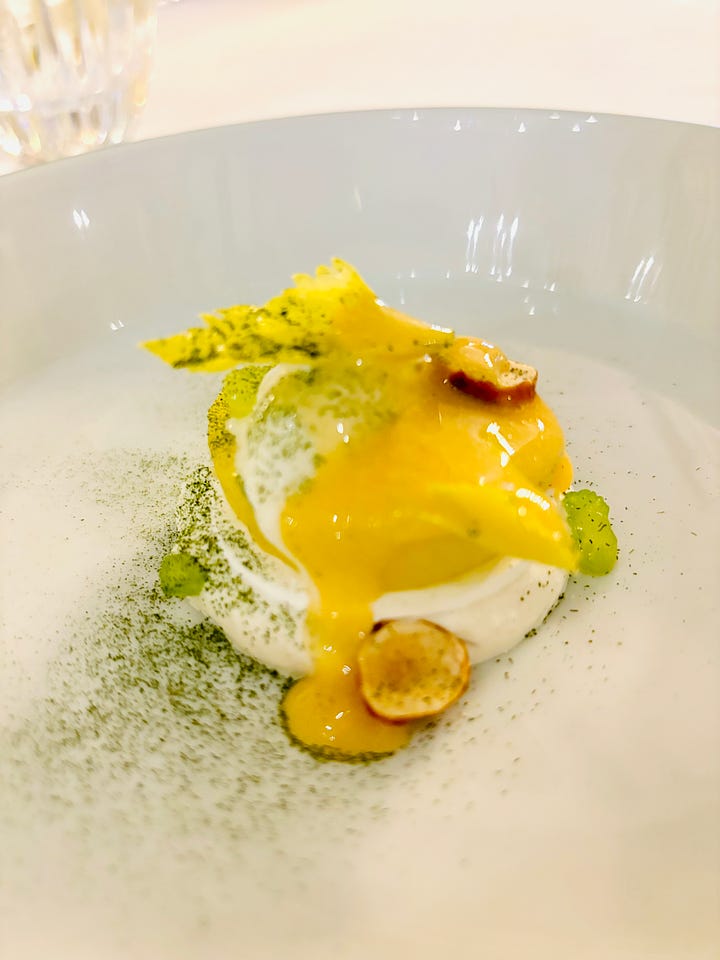

Le Clarence
I rarely go to Michelin-starred restaurants for a variety of reasons, but one is that I don’t really want to sit anywhere for four hours, unless I’m on a plane to a tropical island. And this probably isn’t a popular opinion, but I often find the food isn’t as good as the “experience.” (I prefer the former over the latter.) However, when a friend and I decided to celebrate our birthdays together, belatedly, we decided to go to Le Clarence, which is definitely in the “splurge” category.
There are three options at lunch: Three courses (€150), four courses (€250), and six courses (€380). While the least expensive of those options is the more appealing, financially, after batting back-and-forth between us, I made the executive decision to go for the four courses since I was with a friend and we were celebrating our birthdays together. And what they mean by four courses is four main plates, with lots of extra side plates alongside everything. So the three-course meal ain’t entrée, plat, dessert, like at your local café.
Chef Christophe Pelé is from Brittany, so the food is seafood centric. There are no printed menus, but you can tell them about allergies or aversions when you reserve, and they’ll take care of you. Highlights were the langoustine (above, left) with coriander sauce and the grilled eel with caviar (lower right). The restaurant is located in a swanky 19th-century hôtel particulier (private mansion) and covers several floors. The top floor is a salon with a fireplace, and you’re welcome to take your after-dinner coffee and mignardises (sweet bites, above right) by the fire.




Le Colimaçon
Who knew that one day influencing would become a profession? I never call myself an influencer, even though I’m sitting down right now gently influencing you to check out some of the restaurants I like in Paris. Go figure.
One person who is a good influencer is Cécilia Jourdan who runs the very popular Hello French NYC Instagram account. We’d never met, but she dropped me a message and suggested we meet at her dad’s restaurant, Le Colimaçon, in the Marais. And I was happy to join her.
The Marais is a beautiful neighborhood but isn’t necessarily known for great restaurants. There are a few, but with so many tourists, a number of them aren’t focused on quality. But that’s changing, with places like Parcelles (which is good, but hard to get into) and Bistrot des Tournelles (which is good, but has gotten crowded and prices have gone up; roast chicken is now €39 and steak-frites is €43).
Happily, Cécilia is just as nice in person as she is online, and I started things off by ordering Salade Frisée, the classic Lyonnais salad with frisée, bacon, and eggs. I was expecting more of a traditional version of Salade Frisée, but the version on the menu here takes liberties with it, with the ingredients chopped and fitted into a small bowl. It was fine, but if you’re expecting the original, this isn’t it.
Living in Brooklyn, where it’s an issue (as it is to some in France), Cécilia ordered Foie gras with caramelized pain perdu (French toast), which was very, very good—and rich.
She was kind enough to let me have a bite of the dish, which was thick slices of caramelized bread with sautéed foie gras on top, along with pickled fruit and a touch of cumin.
I hesitated between the stuffed braised rabbit for my main course and the duck confit. I ended up going with the rabbit, which was very good, but after seeing a few plates of duck confit coming out of the kitchen, next time I’m having that.
The “revisited” tarte Tatin for dessert (shown farther above, top left) was a deconstructed caramelized apple tart. If you eat out in France, lately you’ll see (or read on menus) a lot of desserts being revistée (revisited, or revised), deconstructed, served une farandole (as a selection), or in déclinaison, a “declined” dessert, served in bits and pieces of sorts. It was a good dessert and a fun evening with new friends (which included her father), and it fortified me for the bike ride home.
Sellae



After I ate at Sellae, a friend in the journalism business sent me a text: “How was it?” She’d gotten some mixed reviews from friends and readers—as we both had, regarding Rôtisserie d’Argent (which neither of us had been back to to verify), but I brought up Bouillon République, a place that used to be fun and extremely affordable.
But my last meal at Bouillon République was disappointing, the worst part being the tepid Brandade (salt cod and potato casserole), scattered in chunks across my plate, which looked like someone in the kitchen had scraped the last bits out of the pan before it landed in front of me on my plate. If any dish needs to be served piping hot, it’s Brandade. And it’s really easy to serve. I was a little embarrassed as I’d brought visitors there, and they politely poked their way around their plates too.
Located in a neighborhood where probably not many visitors find themselves, Sellae calls itself a néobistro, a contemporary bistro where the food isn’t necessarily “revisited,” but the menu reads more like the way people in Paris are eating now, with a mixture of traditional French dishes with influences and ingredients here and there from other cultures.
Known for its wine list, the wine we’d ordered was…well, fine (I’m not a wine expert, but I do like being delighted by a good bottle of wine), and I thought the œufs mayo (above left) was pretty ordinary, served with just a little pile of mâche. The dish doesn’t need to be reinvented, as others are doing, but it was kind of a let-down compared to the other food.
The restaurant is known for its beef, and the carpaccio of smoked beef with olive oil and Parmesan starter (above, middle) was excellent. Luckily, the serving was big enough for two, so I didn’t feel bad about sharing.




For main courses, Romain had the aged faux filet (above, left) with herb butter and decent frites, but my duck confit (yes, finally!), above, right, was outstanding, served comme un cassoulet with braised Tarbais beans, the bean that makes the classic cassoulet a classic. It was just right.
The Île Flottante for dessert (above, bottom left) wasn’t quite what I was expecting, with pralined nuts and caramel laitier, an ice cream of sorts. But the star of the show here is the Mousse au chocolat tiede (warm chocolate mousse) with vanilla ice cream underneath it. It was as smooth as warm ganache and — although I generally decline to use the word — it was exceptionally comforting and elicited oohs and aahs from us.
We were a little jealous that the couple at our neighboring table opted for the sole for two, which was priced at €70 per person and seemed like a lot. But watching them serve it, expertly boned tableside, along with various accompaniments, which softens the blow of the price, and they said it was great. The other diners in the restaurant seemed like they were really into eating (as opposed to people who are just going somewhere for dinner), which led them to this unassuming corner of the 13th arrondissement. I’d like to go back, although I might try it for lunch, which is offered on weekdays for €25-28, depending on how many courses you want.




Clamato
It’s a little difficult to recommend Clamato. On one hand, it’s easy. The food (and wine) are very good. The difficulty is that the restaurant, which is the seafood-based sister restaurant of Septime, doesn’t take reservations.
But there we were the other night; it was Saturday night and we hadn’t made reservations anywhere for dinner*. So we were thinking about going to the local dumpling place, and just by chance, I said, “Let’s swing by Clamato and see how long the line is.” It was a few minutes before opening, around 6:55pm, and the line wasn’t that long. After they opened at 7pm and started seating people, I calculated there were enough seats, and sure enough, when we got to the front of the line, we snagged a table for 2.
Unfortunately, it’s hit or miss because if you get there at 7:10, the restaurant might be full, and you have to wait for the next table to open up, which’d be 1 1/2 to 2 hours later. You can put your name on the waiting list and head over to their wine bar, Septime Cave, and spend some time there. (Which isn’t a bad thing, but it’s quite small and fills up fast.)
That said, a better strategy is to go for lunch during the week when there are fewer people.
The menu changes often, and everything is meant to be shared. The tarama (fish roe spread), with some of the best olive oil you’ll ever eat, is always a good choice to start with, along with sourdough bread from Ten Belles. There’s always a well-chosen selection of raw oysters and clams to choose from (the ones from Utah Beach in Normandy tend to be excellent), and there are ceviches. We had one made from lieu jaune (pollack) flavored with spruce tips and another made with mulet and seasoned with kimchi. Another small plate was a delicious wedge of cabbage with house-made XO sauce, and we ended the meal with mandarin sorbet and mezcal dusted with piment d’Espelette (Basque chili powder)…although the restaurant is known for the Clamatart, a maple syrup tart that’s also available in their bakery, Tapisserie, across the street. So if you haven’t had that, you don’t want to miss it.
Clamato is not the place to go if someone in your party doesn’t eat seafood (and it’s not the kind of food they can substitute another ingredient on the plate), and note that many dishes feature raw seafood, although some don’t. The young staff is very nice, and the natural wine list is intriguing. We like/love the Domaine de Marnes Blanches chardonnay from the Jura, which is a mid-priced wine (€65/bottle) on their list, but you can find wines starting at €32 and going up from there, as well as wines by the glass. Another time we tried a Greek wine made from muscat grapes on the recommendation of the host, which was medium-bodied and had an earthy-fruity taste, and was fun to try.

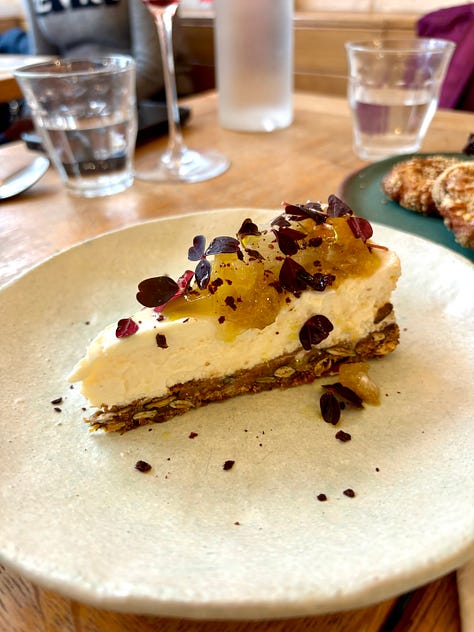

Mokonuts
If I had my way, I’d eat at Mokonuts every week. But it’s so small that you can’t just walk in, although they’re now taking reservations online as many places in Paris (finally!) are. I had a great lunch with baker-pal Fany Gerson, otherwise known as La Newyorkina for her homemade pastries and Mexican-style ice creams and paletas in New York.
We shared first-of-the-season white asparagus with a gently cooked egg and wild garlic, which was superb, as well as a bowl of labneh topped with various chicories (winter lettuces). I didn’t taste the grilled octopus with chickpeas since anything with tentacles scares me, but my tablemate loved it, so I’ll have to take her word for it.
I didn’t snap a pic of the grilled pigeon, which was excellent and showed off the talent of co-owner chef Omar Koreitem, served with stuffed artichoke, Swiss chard, and garlic, but I got a pic of the Ricotta Cheesecake for dessert with buntan (above, center), a citrus fruit I wasn’t familiar with, and one never can go wrong with a plate of Moko Hirayama’s cookies.
Kubri




It’s hard to suggest Middle Eastern food to visitors as many are coming to Paris for French food, and sometimes they need some convincing. But everyone I’ve suggested Kubri to has thanked me. And when Deb Perelman of Smitten Kitchen came to town, I knew she’d love it too.
Cheffe Rita Higgins works magic with flavors of the Levant, using (mostly) French ingredients. I crave her Hispi Cabbage with Aleppo pepper, peanuts, pickled apricots, and shanklish, so I always have to get that. But the Cauliflower Tabbouleh with feta, pistachio, herbs, and lemon-sumac vinaigrette was bright and tangy. Not all visitors (and locals) are enamored of the falafels on the rue des Rosiers, but it’s hard not to love the extra-crisp ones at Kubri, served with three different dipping sauces. Another standout is the hummus with charred broccolini with smoked almonds and za’atar chili crunch. (Note that the menu changes by the season.)
While it’s easy to make a meal of all the méza starters and small plates, the braised lamb shank with freekeh (smoked wheat), pistachios, and spices is one of my absolutely favorite dishes in Paris. When I asked how Rita made it, she told me the long process she goes through, which made me glad I don’t live too far away from Kubri. (You can buy the freekeh here in France, which is also sold at Sabah, 30 rue d’Aligre.)



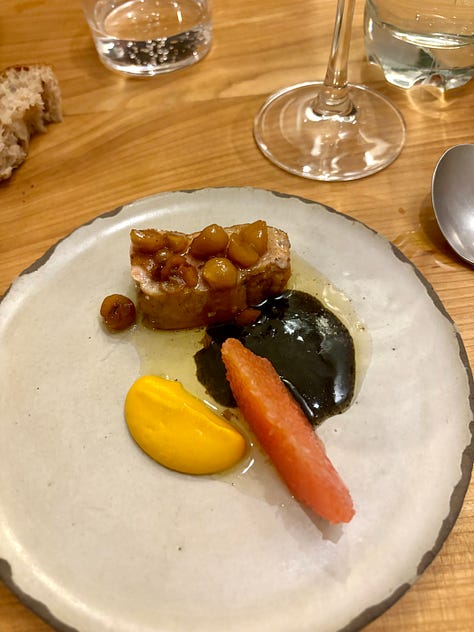


Fulgurances L’Adresse
You need to be the kind of diner who’s willing to take a leap of faith at Fulgurances L’Adresse. The restaurant, which now has a sister restaurant in Brooklyn, changes chefs every few months, so you’re not sure what you’re going to get. I started going eight or so years ago and have had food by wonderful chefs. Then I had a few meals that were just okay, and it fell off my radar. But now that I live just a few blocks away, it’s back on my list, and I have been blown away by meals there.
Late last year, Chef Nazareno Mayol, who worked at some of the best restaurants in France, was in residence (above). (He’s currently cooking at their restaurant in Brooklyn.) Then I had a crazy-good vegetable-based dinner by Estée Strooker that kind of knocked me for a loop…
So when I saw Nicolas Tamburo was coming to Paris to cook at Fulgurances, who was the opening chef at Claud in New York, I quickly reserved a table.
Our dinner started with raw scallops bathed in tangy rhubarb juice, wild garlic leaves, and calendula. Chef Tamburo really wowed us with bowls of clam chowder that were so concentrated with flavor, it felt like he’d managed to get ten bowls of the best clam chowder of our life into two little bowls. (As an aside, chowder may actually be French; the name might come from chaudron, or cauldron, a vessel for making soup over a fire. The chef, and the servers, were surprised when I told them that.)
I’m not a huge fan of monkfish liver, but I’ve never had it fresh (only canned), and this version was really great, served warm with hazelnuts toasted in sherry-spiked brown butter, squash puree, grapefruit, and charred leek vinaigrette. Other courses included white asparagus with house-cured mackerel and rouget, a small Mediterranean fish, with green asparagus tips and ail des ours (wild garlic).
It’s hard to pull off desserts with savory ingredients, but both were excellent: Celery root ice cream with celery cream and coffee oil and preserved cherries was pretty and a great transition from the main courses to dessert. You can add on a cheese course for a supplement, which we did because we had a wonderful bottle of rich Chardonnay from the Jura from Domaine de la Tournelle that was begging to be paired with cheese…and who were we to refuse?
The meal ended with a Napoléon of sorts: layers of silky vanilla custard and candied citrus sandwiched between “leaves” of dried nori, which sounds weird, but was very good. I wouldn’t say so if I didn’t mean it.
Due to the style of service, everyone gets the same menu for dinner at Fulgurances, but you can alert them when you reserve if you have aversions or allergies. You can also choose a wine pairing to go with your meal, although I’m not a fan of trying four to six different wines during dinner. But I am a fan of sommelier Adrian Ruois who is a really sweet guy and will lead you to some very interesting wines from their excellent wine list if you want a bottle or just a few glasses.


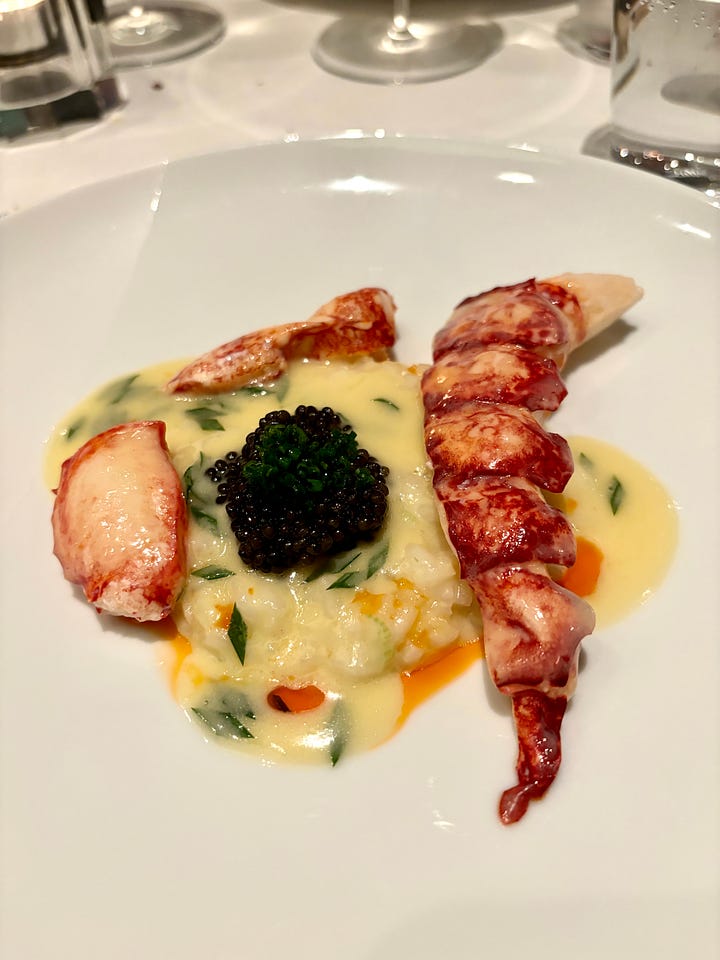

Comice
This past weekend we had an exquisite dining experience by husband (chef) and wife (sommelier) team Noam Gedalof and Etheliya Hananova, at Comice, with Noam talking the reins in the kitchen and Etheliya in charge of the dining room, guiding and selecting the wines.
The fixed menu is a lovely presentation of dishes using well-chosen ingredients that represent the best of France. (The restaurant is happy to make menu adjustments, with advanced notice.) It was a pleasure to have contemporary cooking without any silliness, such as foam or stone plates, that was brilliantly cooked and let the pristine ingredients shine.
A recent meal started with warm cheese-filled gougères, then a bowl of chilled sweet pea soup with bacon and crème fraîche, sea scallops with preserved citrus, lobster poached in beurre blanc with sweet potato and chard ravioli, and a stunning chocolate soufflé for dessert, which were served along with carefully-chosen wines from small producers. The house-made bread (and salted butter!) were both extraordinary.
Bernadette
Before we moved last year, our neighborhood crêperie was Bernadette. I am always up for buckwheat galette (crêpe) and met a friend from New York here, who is a pastry chef, so I knew he’d appreciate a well-made crêpe. He followed my lead and also went for a complète, a buckwheat galette filled with ham, cheese and and a sunny-side up egg. Of course, glasses of sparkling cider are the obligatory accompaniment, although they have an excellent list of ciders from Brittany and Normandy. If you want a treat, try a bottle of Herout sparkling hard cider. (Although their non-alcoholic sparkling apple cider is also excellent.)
If you’re looking for a pleasant place to have lunch in the neighborhood, stop by!
*Two Paris Dining Notes
Restaurants in Paris have gotten very busy, and for most places that you want to eat in Paris, especially on the weekends, you should reserve a minimum of one week in advance, but in some cases two or three. It’s very hard to find a place where you can make a same-day reservation on a weekend, and the few places that are open on Sundays and Mondays fill quickly. Fortunately, many restaurants now take reservations online, which is helpful, and if you need to cancel, be sure you do so, so they can fill the spot.
More and more point-of-sale credit card machines in France have a screen that asks if you’d like to tip and suggests 5%, 10%, 15%, and 20%. Service is always included in France and waitstaff are paid a living wage, comparable to other workers; there’s no “special” (i.e., very low) minimum wage for tipped workers as there is in parts of the U.S., where a server can be paid as little as $2.13 per hour, and tips are expected to make up the difference.
[As an aside, the custom of tipping originated in Europe. It came to America as people wanted to emulate European habits, and was considered elitist.]
You’re never required to tip in France. However, if the service is good and you’ve enjoyed yourself, and if the server went out of their way to accommodate a special request, you are welcome to show your appreciation with a tip. A tip in the 5% to 10% range is acceptable, but some of it depends on the cost of the meal, rather than a fixed percentage. If your meal was €300, a €40 tip would be considered extremely generous. (€20 would be fine.) If the check was €200, €10 would be considered nice, but you could leave €20 if they were especially helpful. If the server was unfriendly or you had problems, there’s no need to leave anything.
Those are just general guidelines, and you can do as you wish. Note: Even French people are a little confused by about how much, and who to leave a pourboire (tip) for. All French restaurant employees have healthcare and retirement benefits provided by their employers (who pay the equivalent of about 40% of the employees salary to the government, for them), although no one minds a little extra money in their pocket at the end of the day.







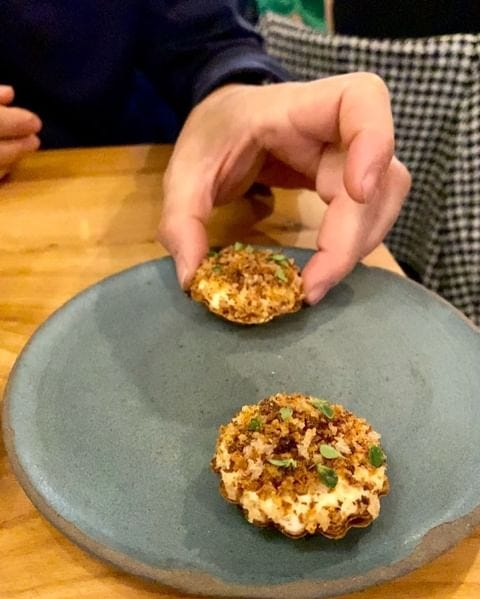



Really appreciate your sharing a range of different places (food, neighborhood, cost) and your candor in describing them.
On your rec, we made reservations at Kubri in December. While there, we loved it so much, we made reservations for the next night too, as we always stay in the 11th. Just really outstanding. Our fave was the Hispi Cabbage too. Had it both nights.
The staff is really friendly too. Anyway, thanks for the 411 :)